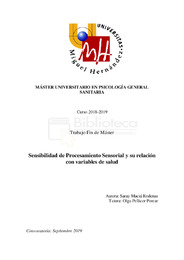Por favor, use este identificador para citar o enlazar este ítem:
https://hdl.handle.net/11000/5542Registro completo de metadatos
| Campo DC | Valor | Lengua/Idioma |
|---|---|---|
| dc.contributor.advisor | Pellicer Porcar, Olga | - |
| dc.contributor.author | Maciá Rodenas, Saray | - |
| dc.contributor.other | Departamentos de la UMH::Psicología de la Salud | es |
| dc.date.accessioned | 2019-12-18T10:40:11Z | - |
| dc.date.available | 2019-12-18T10:40:11Z | - |
| dc.date.created | 2019-09 | - |
| dc.date.issued | 2019-12-18 | - |
| dc.identifier.uri | http://hdl.handle.net/11000/5542 | - |
| dc.description.abstract | La Sensibilidad de Procesamiento Sensorial (SPS) es un rasgo que se caracteriza por una alta sensibilidad para la estimulación y facilidad para la sobreactivación, procesamiento profundo de la información, percepción de estímulos sutiles y fuerte reactividad emocional. A pesar de no ser patológico, puede tener implicaciones negativas para el bienestar de los sujetos. Objetivo: estudiar la relación entre la SPS y la calidad de vida, la salud, el impacto del dolor de cabeza y la somatización. Determinar si existen diferencias entre individuos con alta y baja sensibilidad en la calidad de vida, la salud, el impacto del dolor de cabeza y la somatización. Analizar si aparecen diferencias en función del género en SPS. Método: Se siguió un diseño descriptivo de tipo transversal y se utilizó una muestra constituida por 44 sujetos, 24 hombres y 20 mujeres, todos ellos estudiantes universitarios. Se les aplicaron varios cuestionarios: Highly Sensitive Person Scale, WHOQOL-BREF, SF-36, HIT-6 y LSB-50. Resultados: Se obtuvo una correlación significativa negativa entre la SPS y la calidad de vida, así como entre la SPS y la salud. La correlación entre la SPS y el impacto del dolor de cabeza fue significativa y positiva, al igual que ocurrió con la somatización. Se encontraron diferencias entre el grupo de alta y baja SPS en las variables anteriores. No se hallaron diferencias entre hombres y mujeres en SPS. Discusión: los resultados son consistentes con la literatura y confirman las hipótesis de partida. Este tema es relativamente reciente y requiere una mayor investigación. | es |
| dc.description.abstract | Sensory-Processing Sensivity (SPS) is a trait which is characterized by high sensivity to stimulation and ease of overarousal, deep information processing, perception of subtle stimuli and strong emotional reactivity. Despite the trait not being pathological, it can have negative implications in the subjects’ well-being. Objective: study the relationship betwen sensory-processing sensivity and quality of life, health, headache impact and somatization. Determine if there are any differences between high and low sensitivity in quality of life, health, headache impact and somatization. Analyze if gender differences appear in SPS. Method: a descriptive cross-sectional design was followed and a sample of 44 subjects, 24 men and 20 women, all of them university students, was used. Several questionnaires were applied to them: Highly Sensitive Person Scale, WHOQOL-BREF, SF-36, HIT-6 and LSB-50. Results: a significant negative correlation betwen SPS and quality of life was obtained, as well as between SPS and health. The correlation between SPS and headache impact was significant and positive, as was the case with somatization. Differences were found between the group of high and low SPS in previous variables. No differences were found between men and women in SPS. Discussion: the results are consistent with the literature and confirm the starting hypotheses. This topic is farly new and requires further research. | es |
| dc.format | application/pdf | es |
| dc.format.extent | 52 | es |
| dc.language.iso | spa | es |
| dc.rights | info:eu-repo/semantics/openAccess | es |
| dc.subject | Calidad de vida | es |
| dc.subject | Salud | es |
| dc.subject | Cefalea | es |
| dc.subject | Somatización | es |
| dc.subject.other | CDU::1 - Filosofía y psicología::159.9 - Psicología | es |
| dc.title | Sensibilidad de Procesamiento Sensorial y su relación con variables de salud | es |
| dc.type | info:eu-repo/semantics/masterThesis | es |
| dc.type | info:eu-repo/semantics/masterThesis | es |

Ver/Abrir:
MACIA Saray TFM.pdf
2,98 MB
Adobe PDF
Compartir:
 La licencia se describe como: Atribución-NonComercial-NoDerivada 4.0 Internacional.
La licencia se describe como: Atribución-NonComercial-NoDerivada 4.0 Internacional.
.png)